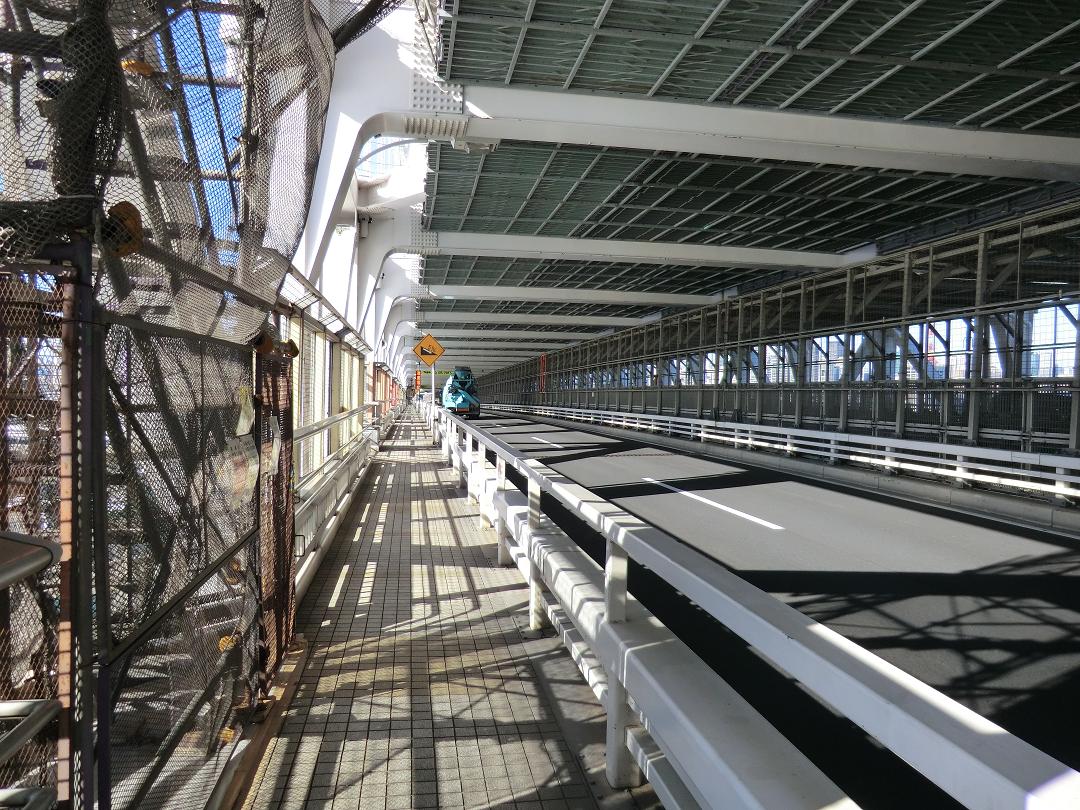Rainbow Bridge (Tokyo) on:
[Wikipedia]
[Google]
[Amazon]

 The is a suspension bridge crossing northern
The is a suspension bridge crossing northern
Tokyo Bureau Of Port and Harbour - Rainbow Bridge
Retrieved October 4, 2015 Bicycles are permitted on the condition that they are pushed (as opposed to riding them).
Rainbow Bridge
(Metropolitan Expressway Co., Ltd.) * {{Minato, Tokyo Odaiba Bridges completed in 1993 Bridges in Tokyo Suspension bridges in Japan Railway bridges in Japan Buildings and structures in Minato, Tokyo Former toll bridges in Japan 1993 establishments in Japan Road-rail bridges in Japan Double-decker bridges

Tokyo Bay
is a bay located in the southern Kantō region of Japan, and spans the coasts of Tokyo, Kanagawa Prefecture, and Chiba Prefecture. Tokyo Bay is connected to the Pacific Ocean by the Uraga Channel. The Tokyo Bay region is both the most populous ...
between Shibaura Pier and the Odaiba
today is a large artificial island in Tokyo Bay, Japan, across the Rainbow Bridge from central Tokyo. Odaiba was initially built in this area for defensive purposes in the 1850s. Reclaimed land offshore Shinagawa was dramatically expanded du ...
waterfront development in Minato, Tokyo
is a special ward in Tokyo, Japan. It is also called Minato City in English.
It was formed in 1947 as a merger of Akasaka, Azabu and Shiba wards following Tokyo City's transformation into Tokyo Metropolis. The modern Minato ward exhibits ...
, Japan.
It is named ''Tōkyō Kō Renrakukyō'' (東京港連絡橋) as the official name in Japanese.
It was built by Kawasaki Heavy Industries
(or simply Kawasaki) is a Japanese public multinational corporation manufacturer of motorcycles, engines, heavy equipment, aerospace and defense equipment, rolling stock and ships, headquartered in Chūō, Kobe and Minato, Tokyo, Japan. It ...
, with construction starting in 1987 and completed in 1993. The bridge is long with a main span of . Officially called the " Shuto Expressway No. 11 Daiba Route - Port of Tokyo Connector Bridge," the name "Rainbow Bridge" was decided by the public.
The towers supporting the bridge are white in color, designed to harmonize with the skyline of central Tokyo seen from Odaiba. There are lamps placed on the wires supporting the bridge, which are illuminated into three different colors, red, white and green every night using solar energy obtained during the day.
The bridge can be accessed by foot from Tamachi Station (JR East
The is a major passenger railway company in Japan and is the largest of the seven Japan Railways Group companies. The company name is officially abbreviated as JR-EAST or JR East in English, and as in Japanese. The company's headquarters ar ...
) or Shibaura-futō Station ( Yurikamome) on the mainland side.
Usage
The Rainbow Bridge carries three transportation lines on two decks. The upper deck carries the Shuto Expressway's Daiba Route, while the lower deck carries the Yurikamome rapid transit system in the centre, walkways on the outer side, and Tokyo Prefectural Route 482 in-between. Light motorcycles under 50cc are not permitted on either deck or the walkway of the bridge. Motorcyclepillion
A pillion is a secondary pad, cushion, or seat behind the main seat or saddle on a horse, motorcycle, bicycle or moped. A passenger in this seat is said to "ride pillion". The word is derived from the Scottish Gaelic for "little rug", ''pillean ...
passengers are also banned.
Walkway
The bridge has two separate walkways on the north and south sides of the lower deck; the north side offers views of the inner Tokyo harbour and Tokyo Tower, while the south side offers views of Tokyo Bay and occasionallyMount Fuji
, or Fugaku, located on the island of Honshū, is the highest mountain in Japan, with a summit elevation of . It is the second-highest volcano located on an island in Asia (after Mount Kerinci on the island of Sumatra), and seventh-highes ...
. The walkways may only be used during certain hours (9 am to 9 pm in the summer; 10 am to 6 pm in the winter, access to the walkways close 30 minutes before closing time.)Retrieved October 4, 2015 Bicycles are permitted on the condition that they are pushed (as opposed to riding them).
Panorama
See also
* Akashi Kaikyo Bridge * Tokyo Bay Aqua-Line * Yokohama Bay Bridge * List of bridges in Japan * List of longest suspension bridge spansReferences
External links
Rainbow Bridge
(Metropolitan Expressway Co., Ltd.) * {{Minato, Tokyo Odaiba Bridges completed in 1993 Bridges in Tokyo Suspension bridges in Japan Railway bridges in Japan Buildings and structures in Minato, Tokyo Former toll bridges in Japan 1993 establishments in Japan Road-rail bridges in Japan Double-decker bridges